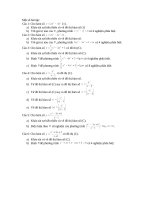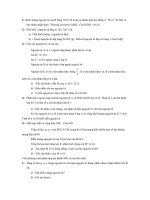Bài tập hàm tài chínhTin học UDTKD
Bạn đang xem bản rút gọn của tài liệu. Xem và tải ngay bản đầy đủ của tài liệu tại đây (142.79 KB, 4 trang )
Bài tập về Hàm tài chính
1. You have just won the lottery. At the end of each of the next 20 years you will receive a
payment of $50,000. If the cost of capital is 10 percent per year, what is the present
value of your lottery winnings?2. A perpetuity is an annuity that is received forever. If I rent out my house and at the
beginning of each year I receive $14,000, what is the value of this perpetuity? Assume
an annual 10 percent cost of capital. (Hint: Use the PV function and let the number of
periods be many!)
3. I now have $250,000 in the bank. At the end of each of the next 20 years I withdraw
$15,000. If I earn 8 percent per year on my investments, how much money will I have
in 20 years?4. I deposit $2,000 per month (at the end of each month) over the next 10 years. My
investments earn 0.8 percent per month. I would like to have $1 million in 10 years.
How much money should I deposit now?5. An NBA player is receiving $15 million at the end of each of the next seven years. He
can earn 6 percent per year on his investments. What is the present value of his future
revenues?
6. At the end of each of the next 20 years I will receive the following amounts:
Open table as spreadsheet
Years Amounts
1–5
$200
6–10 $300
11–20 $400
Use the PV function to find the present value of these cash flows if the cost of capital is
10 percent. Hint: Begin by computing the value of receiving $400 a year for 20 years
then subtract the value of receiving $100 a year for 10 years, etc.7. We are borrowing $200,000 on a 30 year mortgage with an annual interest rate of 10
percent. Assuming end-of-month payments, determine the monthly payment, interest
payment each month, and amount paid towards principal each month.
Answer each question in Problem 7 assuming beginning-of-month payments.
8. Use the FV function to determine the value to which $100 accumulates in three years if
you are earning 7 percent per year.
9. You have a liability of $1,000,000 due in 10 years. The cost of capital is 10 percent per
year. What amount of money would you need to set aside at the end of each of the next
10 years to meet this liability?
10. You are going to buy a new car. The cost of the car is $50,000. You have been offered
two payment plans:o A 10 percent discount on the sales price of the car, followed by 60 monthly
payments financed at 9 percent per year.
1
o
No discount on the sales price of the car, followed by 60 monthly payments
financed at 2 percent per year.
If you believe your annual cost of capital is 9 percent, which payment plan is a better
deal? Assume all payments occur at the end of the month.
11. I presently have $10,000 in the bank. At the beginning of each of the next 20 years I am
going to invest $4,000 and I expect to earn 6 percent per year on my investments. How
much money will I have in 20 years?
12. A balloon mortgage requires you to pay off part of a loan during a specified time
period and then make a lump sum payment to pay off the remaining portion of the loan.
Suppose you borrow $400,000 on a 20 year balloon mortgage and the interest rate is .5
percent per month. Your end-of-month payments during the first 20 years are required
to pay off $300,000 of your loan and 20 years from now you will have to pay off the
remaining $100,000. Determine your monthly payments for this loan.13. Suppose we have borrowed money at a 14.4 percent annual rate and we make monthly
payments. If we have missed four consecutive monthly payments, how much should
next month’s payment be to catch up?14. We want to replace a machine in 10 years and we estimate our cost will be $80,000. If
we can earn 8 percent annually on our investments, how much money should we put
aside at the end of each year to cover the cost of the machine?15. We are buying a motorcycle. We pay $1,500 today and $182.50 a month for three
years. If the annual rate of interest is 18 percent, what was the original cost of the
motorcycle?16. Suppose the annual rate of interest is 10 percent. We pay $200 a month for two years,
$300 a month for a year, and $400 a month for two years. What is the present value of
all our payments?17. We can invest $500 at the end of each six-month period for five years. If we want to
have $6,000 after five years, what is the annual rate of return we need on our
investments?
18. I borrow $2,000 and make quarterly payments for two years. The annual rate of interest
is 24 percent. What is the size of each payment?
23. You have a choice of receiving $8,000 each year beginning at age 62 and ending when
you die, or receiving $10,000 each year beginning at age 65 and ending when you die.
If you think you can earn an 8 percent annual return on your investments, which will
net the largest amount?
24. You have just won the lottery and will receive $50,000 a year for 20 years. What rate of
interest would make these payments the equivalent of receiving $500,000 today?
25. I need to borrow $12,000. I can afford payments of $500 per month and the annual rate
of interest is 4.5 percent. How many months will it take to pay off the loan?
Tính NPV
26. An NBA player is to receive a $1,000,000 signing bonus today and $2,000,000 one
year, two years, and three years from now. Assuming r=0.10 and ignoring tax
considerations, would he be better off receiving $6,000,000 today?
27. A project has the following cash flows:
2
Open table as spreadsheet
Now
One year from now Two years from now Three years from now
–$4 million $4 million
$4 million
–$3 million
If the company’s cost of capital is 15 percent, should it proceed with the project?
28. Consider a project with the following cash flows. Determine the project’s IRR. If the
annual cost of capital is 20 percent, would you undertake this project?
Open table as spreadsheet
Year 1 Year 2 Year 3
–$4,000 $2,000 $4,000
29. Consider the following two projects. Assume a company’s cost of capital is 15 percent.
Find the IRR and NPV of each project. Which projects add value to the company? If
the company can choose only a single project, which project should it choose?
Open table as spreadsheet
Year 1 Year 2 Year 3 Year 4
Project 1 –$40
$130
$19
$26
Project 2 –$80
$36
$36
$36
30. 25-year-old Meg Prior is going to invest $10,000 in her retirement fund at the
beginning of each of the next 40 years. Assume that during each of the next 30 years
Meg will earn 15 percent on her investments and during the last 10 years before she
retires, her investments will earn 5 percent. Determine the IRR associated with her
investments and her final retirement position. How do you know there will be a unique
IRR? How would you interpret the unique IRR?
1. Một TSCĐ nguyên giá 150 triệu đồng, dự tính khấu hao trong 10 năm. Giá trị đào
thải ước tính là 10 triệu đồng. Tính lượng trích khấu hao và giá trị còn lại của từng năm
theo phương pháp khấu hao đều.
2. Một TSCĐ nguyên giá 50 triệu đồng, dự tính khấu hao trong 7 năm. Giá trị đào thải
ước tính 10 triệu đồng. Hãy tính lượng trích khấu hao và giá trị còn lại của TSCĐ theo
phương pháp khấu hao đều (SNL), theo tổng số năm sử dụng (SYD), khấu hao theo
phương pháp số dư giảm dần (DB)
. C ng ty đia ốc DDHC bán căn hộ với phương th c trả g p cụ th như sau giá căn hộ
00 triệu đồng, ngư i mua trả trước 0 , phần c n lại trả đều trong 5 năm với l i suất
3
cố định hàng năm là 11 . Tính số tiền phải trả hàng năm, phần vốn và phần l i hàng
năm.
4. Một ngư i hiện đang 40 tuổi lập kế hoạch cho tương lai bằng cách mua bảo hi m c
đều đặn nửa năm đ ng $2000 với lãi suất kh ng đổi 10.5 /năm trong 25 năm liên tục.
Khi đủ 25 năm thì bắt đầu nghỉ hưu (65 tuổi) và sẽ rút trong 10 năm liên tục đến khi
ngư i đ 75 tuổi, vào cuối mỗi năm. Hỏi ngư i đ được rút đều đặn mỗi năm bao nhiêu
tiền. bỏ qua lạm phát.
5. hà đầu tư ba u nh hiện c 50 triệu đồng nếu g i ng n hàng th l i suất hiện tại
klà
. Tuy nhiên c 2 phương án đầu tư như sau
- A1 H n vốn vào dự án nu i t m h m, sau 4 năm sẽ thu được 00 triệu.
- A2 H n vốn vào dự án nu i gà, mỗi năm chia được 120 triệu. goài ra, đến năm th
4 khi thanh l trài gà sẽ nhận được thêm 100 triệu.
. H y xác định l i suất thực trong các trư ng hợp l i nhập vốn theo tháng, theo u ,
theo tháng, theo tuần, theo ngày. Được biết l i suất danh ngh a là 10 /năm.
7. C ng ty thế k 21 bán căn hộ trả g p tại cao ốc Hapy 21 century số 52 Hu nh Tấn
hát 7 với các loại căn hộ và uy định thanh toán như sau
Diện tích
Đơn giá
Đ ng trước
i suất
- Căn hộ A
120
15.0
30%
1%
- Căn hộ B
90
15.2
30%
1%
- Can hộ C
60
15.3
30%
1%
a H y tính số tiền trả g p hàng tháng trả đều với số tiền kh ng đổi với th i gian là 5
năm, 10 năm.
b Trong trư ng hợp ngư i mua căn hộ A trả g p 5 năm và cho thuê. ỗi tháng tiền
thuê là 15 triệu/tháng và đến cuối năm th 5 dự kiến là căn hộ bán được 2500 triệu vậy
nhà đầu tư c th sinh l i là bao nhiêu
và suất sinh l i là bao nhiêu IRR . hư
vậy đầu tư này c hiệu uả kh ng?
8) Một công ty dự định mua 1 thiết bị với giá 50 triệu đồng, dự tính sử dụng trong 5
năm với giá trị còn lại dự kiến là 0. Giả sử chi phí vận hành bình quân trên một năm là
9,5 triệu đồng, thu nhập hàng năm dự kiến là 28 triệu . Cho biết thuế thu nhập là 28%,
60% tiền mua thiết bị là tiền vay với lãi suất là
/năm trả đều trong năm 5. Khấu hao
tài sản theo phương pháp SLN. Hãy tính NPV của dòng tiền mà doanh nghiệp thực
nhận hàng năm với m c chiết khấu
/năm. Công ty có nên mua tài sản đ hay không.
4









